The flywheel framework was born out of necessity so businesses can find new ways to better engage and continually deliver value in a customer-centric world.
Where the traditional sales funnel left the customer to fend for themselves, the flywheel keeps the customer at the center indefinitely, with an ongoing focus on delighting customers from all aspects of your organization, including marketing, sales, and service.
When inbound dwells inside your entire culture, you can maximize force throughout the flywheel, generating business growth as you continually delight your customers at every stage. But of course, nothing is perfect, and this is where friction points come in.
Friction is what kills the momentum of your flywheel, so you need to know exactly where it will crop up within your flywheel for every team in your organization.
Here are 15 friction points each team experiences throughout the flywheel and tips on how to reduce and even prevent that friction:
Friction Points in Marketing
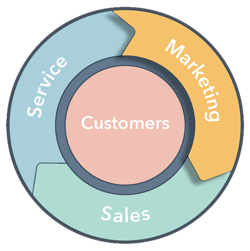
Your marketing team excels at creating and distributing awesome content and building an effective strategy based on trends and analytics. They're essential in attracting and delivering qualified leads to your sales team, but there are a few friction points that are common and disruptive.
Your content isn't attracting relevant readers.
The old adage "content is king" is nonsense if your content marketing assets are thin or not speaking to your target audience in a meaningful way. Even if you're getting a lot of readers, what matters most is how relevant those readers are to your company.
If your website visitors are rising but you're not bringing in more leads, you need to rethink your content strategy. There are a few simple changes you can make:
- Build buyer personas – If you don't know who you're writing for, you don't know what challenges to address. Conduct research, compile your personas, and start planning content ideas.
- Map your content – With personas in mind, start mapping all your content to each persona at every stage of their buyer's journey. If you don't provide high value content in every stage, your readers will likely find what they're looking for elsewhere.
- Adopt topic clustering – Research keywords and topics your target audience is searching for, then build content campaigns around them. This improves your SEO strategy and attracts the right readers who are looking for solutions.
Your social media is anti-social.
This aligns perfectly with what HubSpot CEO Brian Halligan's point he addressed at Inbound 2018 – word of mouth is much more important now than ever before.
Social proof, which can be demonstrated and earned in social media, carries a lot more weight than what searchers are finding online or what sales teams can tell prospects. There's a lot of distrust as more people are taking what they read on the internet with a grain of salt.
But awesome customer reviews and personal referrals and recommendations stand out a lot.
There are a few simple ways you can prevent this friction point. First, you need to be present on your social media channels. This requires ongoing social monitoring to listen to what your audience is saying about you and your competitors.
While you're present, you also need to be engaging. Adopt a social media engagement practice that gets you and your brand to quickly respond to direct messages and to jump in on social conversations.
But boilerplate, dry responses feel too corporate and inauthentic. Make sure you're adding a human element to your messaging. Develop a social media voice that aligns with your brand and adds personality to your interactions.
You aren't measuring the correct metrics.
This is where vanity metrics can be a danger to marketing. These metrics are incredibly satisfying when you see them on paper. Metrics like social media followers, pageviews, blog subscribers, and sessions are important, but they're not the end all be all.
The metrics you want to really pay attention to are not so much about impressions, unless they lead back to website visitors and conversions. Obviously brand awareness matters from that perspective and these are good to stay in tune with, but visitors to your site and social media ultimately don't do much.
It’s easy to get caught up in so many likes visitors. For a business, why do we care?
The exception to this is if these vanity metrics can be attributed to lead generation. Because at the end of the day, marketing is all about feeding leads to the sales team.
Sales takes leads and turn them into revenue. Period.
And that is best achieved by getting your marketing and sales teams to work together.
Friction Points in Smarketing
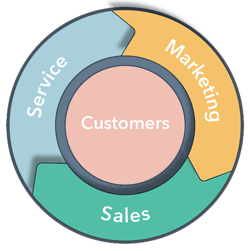
In between marketing and sales within the flywheel is smarketing – alignment between your sales and marketing teams. This is essential when you consider the lead handoff process.
But there are plenty of friction points to be aware of that exist between sales and marketing as well.
Marketing doesn't properly identify leads.
As marketing generates leads, they need to know how qualified these leads are. Unfortunately, a lot of marketing teams don't fully grasp how to qualify leads.
When leads enter your marketing machine, you want to know their designated lifecycle stage so sales can fully understand where each lead is in terms of their readiness to buy.
This is where the prospect fit matrix comes in. It walks your team members through the entire lead qualification stage, which helps to prioritize good-fit, ready-to-buy leads for sales to contact and to find the less interested leads for marketing to further nurture.
Both teams lack clarity on process and goals.
The disconnect between sales and marketing will slow down your business growth immensely. Marketing might not be delivering good-fit prospects to sales. Or they might not be delivering enough qualified leads to help sales hit their revenue goals.
Your organization needs a clear agreement on goals for marketing and sales and the process of handing off leads. And your best tool for this is creating a service level agreement (SLA).
This delineates how many monthly leads marketing needs to deliver and what that process looks like. The signed document also makes the commitment legitimate and confirmed between both teams.
Part of the lead handoff process should also include steps for sales to provide feedback to marketing. As sales is closing deals, they also need to tell marketing where the leads are missing the mark. Additionally, sales should establish when a lead needs to be funneled back to marketing for more lead nurturing to get that lead ready to buy in the future.
Friction Points in Sales
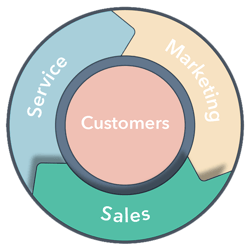
Your sales team drives revenue and fuels your flywheel speed. With the right processes in place, sales can hit the ground running with prospecting. But without the right processes, you're likely to hit a few friction points along the way.
Your prospecting process is outdated (or nonexistent).
If your marketing department is not yet producing enough Sales Qualified Leads to you sales team, you may still be dependent on prospecting to get these leads. If so, then your prospecting needs to be done with inbound methodology in mind. And that comes down to two words: Help first.
Solve for your customer at the beginning of the buyer's journey. First, help them identify issues and understand how your company can help them. With this in mind, then you can better find your prospects.
This is a huge leap forward and away from the flawed prospecting tactics from pre-inbound sales times. As opposed to hammering a broad database and relying on cold calling and spamming emails, inbound is far more strategic.
Thanks to account based marketing, which consists of finding the best fit prospects, you're better prepared to personalize messaging and find the right solutions you can offer.
This makes social prospecting much easier. You can connect through social media, bring them in your network, and share your content to educate them.
Unfortunately, there are still plenty of sneaky tactics being pulled in social prospecting, like cold connecting. You receive a connection request from someone you don't know, and then once you accept their connection in LinkedIn, you receive a canned pitch from them.
This needs to go.
Instead, with an inbound mentality, you can offer information for free and focus on showing prospects how to solve their problems on their own. The new mindset is this: If you want to use our product, that's great. But that's not the main goal.
Your technology is slowing you down.
This is all too common. Best case scenario, your business has all the best technology set up. Your website is awesome, and your content marketing efforts are bringing in a lot of leads. Marketing is setting your sales team up for success.
But then sales drops the ball. They get stuck in the old school selling mindset, feeling more concerned about their products and services than about the prospect's needs and where they are in the buyer's journey.
Most companies are still updating their website to be a branding mechanism, but they're not building it with the inbound philosophy in mind. They're not focused on making their website a lead nurturing machine.
In terms of sales technology, the prerequisite for making the most out of it is adopting the inbound mentality. With that in place, you can make the most of four important technologies:
1. Your CRM
Manual processing and data management is tedious and drains your resources. But when you invest in a CRM that is intuitive and automatically captures lead data for you, you equip sales with a robust database that tells them everything they need to know about prospects so they can personalize their outreach.
2. Prospect Data
Where do your prospects spend most of their time? How do they prefer to communicate? As you capture more data on your prospects, you learn about how to best reach them.
It used to be simply calling someone on the phone or sending an email, but now there are plenty of other communication channels they might prefer. For example, you can find them through social media channels like LinkedIn and then reach out directly. Text messaging, online chat, social channels — you name the channel, they could be using it.
That's the most important aspect to focus on — their preferences.
Don't make them conform to your communication channels and your preferences. Reach out to them where they want to be . With accurate, updated data on your prospects, you can better understand how and when to reach out.
3. Rich Media
Sales professionals are more focused on education, but not all prospects learn the same way. Simply sending a text-heavy email is not always the best way to teach prospects about how your products or services address their challenges.
Instead, diversify your outreach with rich media, like audio and video. For example, record a walkthrough to demonstrate how your software addresses a major challenge they previously spoke about. Video, animations, and other visual aids can be consumed faster and might help prospects better retain pertinent information.
4. Social Prospecting
There are plenty of social prospecting tools you can use, but one of the best ones that sticks out is LinkedIn Sales Navigator. Social prospecting technology makes it easy for your sales team to personalize outreach, manage their lead database, and prioritize who to reach out to first.
The old school sales process is still lingering.
In sales, getting information in an altruistic way is essential. When prospects raise their hands, altruism is even more critical.
Consider the sales process from their prospective. They found your company through search or a personal recommendation. After reading about your products and services and learning from your content, they start to trust you and view you as an authority in the industry.
When they raise their hand, they don't want a sales pitch and pushy, old school tactics that pressure them into buying right now. They want to be further educated.
Again, this comes down to mentality. An old school sales mindset will cause friction throughout every stage of your sales process.
But when you focus on their problems and guide them through how to solve them, you're further developing a positive rapport and meaningful relationship.
Your sales team should be made up of professionals who want to be trusted advisors and guides. With that approach, you learn how to use the prospect's language and to adjust your sales processes to fit their needs and timelines.
It all comes down to how your prospects prefer to move forward and making every outreach message purposeful. The old days of sending emails "just to touch base" are over. Instead, your team should be sending messages with a specific purpose that include educational resources to empower them.
You need a defined process with stages that are supported through helpful content. But process is just one side of the coin.
You also need people who are not stuck in their ways or who are not willing to embrace technology. When you build a team of salespeople who embrace change to keep up with the way people buy and who believe in your inbound sales process, you're well on your way to sustainable sales success.
Friction Points in Client Onboarding
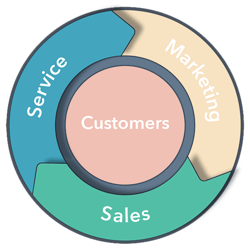
Between sales and service lives onboarding. This is the process of getting new clients/customers up to speed and ensuring they fully understand how to use your product or service. But when sales and service don't work together, there are plenty of areas you can experience friction.
Your customers don't have clear expectations.
After marketing converted a visitor into a lead, they nurtured them. Sales provided personalized outreach messages and walked the lead through how your company can provide them with a solution, and they closed the deal.
Now what?
Your customers deserve to know what the next steps are. Otherwise, they will feel confused and may experience some buyer remorse.
Avoid this friction point by developing a written process for onboarding. This acts as a pathway so your customer can comprehend the next steps and has a clear set of expectations.
Your onboarding isn't customer-centric.
Too many organizations default to a standard process that they force on every customer. The "this is how we do it" approach is limiting and can rub customers the wrong way.
To deliver a truly remarkable customer experience, put their interests at top of mind first. Consider how they want to be onboarded and how they want to be guided through using your products or services.
Friction Points in Service
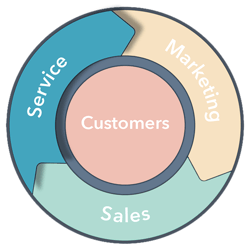
Your service team is what keeps the momentum going after sales closes deals and onboards new customers/clients. But service isn't what it used to be. To stand out from your competition, focus on preventing these friction points.
Your knowledge base falls short.
A knowledge base is a must have in the digital age we live in today. Most customers are not happy calling a service line and waiting on hold for the next available rep.
The world of now demands you have answers ready at a moment's notice. If your customer needs help at 10 o'clock at night, you should provide them with plenty of educational content online.
Don't just cover a few common obstacles. Encourage your service team to collaborate with sales and marketing to help brainstorm and build out a full knowledge base to cover all the bases.
Make your knowledge easily accessible (in other words, keep it ungated), and simplify the user experience by making it searchable. This way, your customers can jump in and find answers to their questions instantly.
You aren’t using rich media to appeal to all types of learners.
As I said before, not everyone learns the same way. This is why you want to provide answers to service questions in other forms of media.
Strive to give your customer information the way they want it. If they need a video on troubleshooting your software, you need to create it for them.
Use various kinds of rich media so no matter their style of learning, they can consume educational content in a way that is most engaging and impactful.
Also, use live chat and chat bots so customers can engage with your brand at any time in a convenient way. Don't make your customers feel like they're left in the dark.
Your support is only through your team, not a community of existing customers.
Forcing your customers to only speak with your team is another major obstacle for service teams. Not only will this create long wait times, but it will also bog down your service team.
Instead, leverage your customer base as advocates for your products and services. They can provide helpful solutions to problems they personally encountered through an online community you can host on your website. They become unpaid support staff essentially.
HubSpot does an excellent job at making support user friendly. They provide access to a knowledge base, phone and chat support with their service team members, and a huge community that addresses every aspect of all their products and services.
Friction Points in Service and Marketing
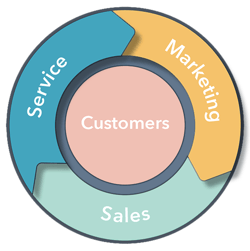
Service should be collaborating with marketing in ways to fully maximize force through your flywheel. But unfortunately, many organizations are overlooking the value of this collaboration, leading to a couple of crucial friction points.
You're not upselling and cross-selling.
Most businesses still think of service as simply team members who work to solve problems for customers all day. But this is a major oversight.
You must see marketing and service in conjunction. The main goal for service is to focus on answering one simple question: How can we make the customer experience even better?
This is where upselling and cross-selling come in handy. Service should reach out to marketing to identify how to provide the most value to existing customers. The answer might be for service to suggest other products or services that could deliver even more benefits to customers.
Services doesn't know how to educate.
Customer service should identify upselling and cross-selling opportunities, but what happens after this? Service likely doesn't know how to properly teach existing customers how other products and services specifically benefit them.
This is where marketing is essential. They need to have the right messaging ready to send for every upselling and cross-selling opportunity. With the right pieces of content, like an ebook, webinar, or blog article, service representatives can further educate current customers on another specific solution to their problems.
As you can see, friction points can show up in every area of your organization. However, they're entirely preventable. The first step to maximizing your business growth is adopting the inbound methodology throughout your entire organization. Then, you're ready to grow at a speed you've never seen before.

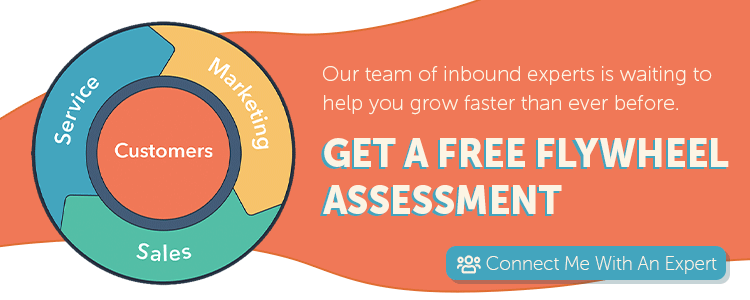
Eric Baum
Eric is the CEO / Founder of Bluleadz. His passion is growing businesses and listening to Jimmy Buffet. Oh yeah, and golf when he can find the time.